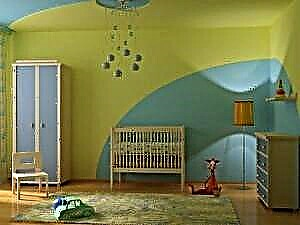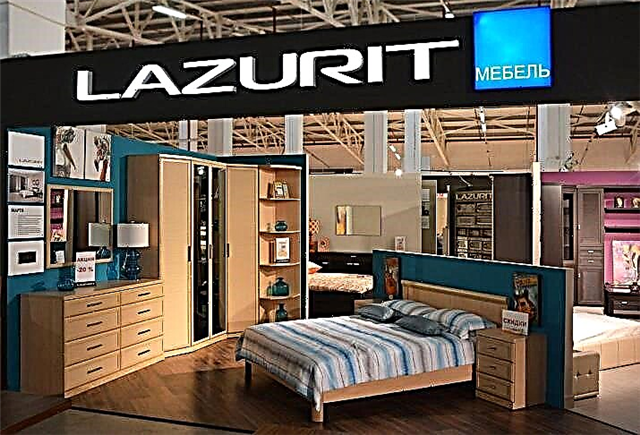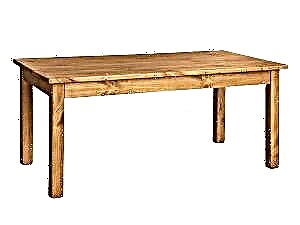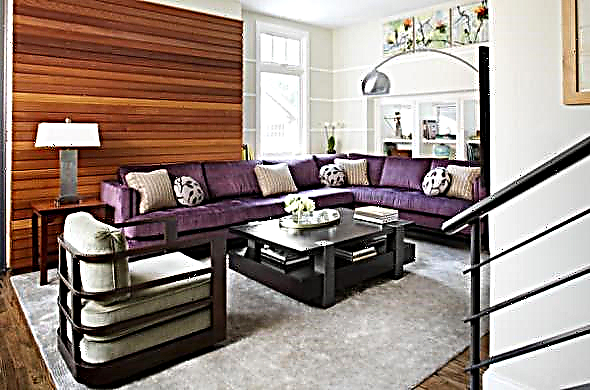
Water-based emulsion paints are replacing adhesive paints, which have many advantages.
- They are bred with water, therefore, they are not toxic.
- The ceiling and walls painted with these paints pass water vapor and air, i.e. "Breathe".
- The applied coatings can be washed.
- Paints have good hiding power (and if you add a little chalk and turpentine to the paint, you get a paste that has an even higher hiding power, it covers wood surfaces especially well).
- Water-based paints can be applied to surfaces previously coated with adhesive, oil, enamel paints. Here, however, it must be remembered that water-based emulsion paints can be applied to adhesive paints if vitriol or alum primers that destroy water-based paint were not used as primers for adhesive paints. Since most often no one remembers what the primer was, it is best to wash off the adhesive paint, proliferate the surface and apply a water-based paint for 2 times with a foam roller.
One of the drawbacks of this paint is its low frost resistance, therefore it can only be stored at a positive temperature, in frost it irreversibly loses its properties.
How to use
The paint is applied using a brush, roller, spray gun. After water evaporation, the paint forms a matte, durable, colorful coating.
Before painting walls previously coated with oil paints or enamels, the surfaces must first be washed with soapy water or detergent, then with clean water, primed with diluted paint (enamel) or drying oil (with oil paint) and painted with a foam roller or spray gun.
The drying time of the paint is 1-2 hours, with the addition of pigment you can get almost any color.
How to make the right choice of paint
To choose the right paint, you need to know the following. Any paint in its designation has 5 groups, for example, polyvinyl acetate water-based paint has an EVA-17 index of white.
The first word or group indicates the type of material, it can be paint, enamel, varnish, primer or putty.
The second group speaks about the chemical composition of the paint or other material: EVA - emulsion vinyl acetate, MA - oil, KO - organosilicon, PF - pentaphthalic, etc. The next group (the first number after the dash) means 1.4 - the paint can be used for exterior works (and if 4, then you can even paint the bottoms of boats), of course, this paint is also used for interior work, 2 - you can paint with this paint only on the inside, 0 - primer or heavy paint, 00 - putty.
The following numbers simply indicate the serial number assigned to the paint, but not for oil paints. The second after the dash, the number for MA paints shows the type of drying oil on which this paint is prepared: 1 - natural, 2 - "oxol", 3 - gliftal, 4 - pentaphthal.
Pros and cons of water based paint
 Water emulsion is a publicly available, high-quality and reliable material. The substance can easily be applied to a variety of surfaces: plaster, wood, concrete, etc. It is important that the emulsion is very environmentally friendly.
Water emulsion is a publicly available, high-quality and reliable material. The substance can easily be applied to a variety of surfaces: plaster, wood, concrete, etc. It is important that the emulsion is very environmentally friendly.
Aqueous emulsion dye is inexpensive, which is one of its advantages. In terms of quality, this material can be worthy of competition. professional oil mixtures. Using the color scheme, you can easily choose the right colors of water-based paint for walls.
But the most obvious advantage of water-based paint for walls is the speed with which it dries.
 It is also interesting that with surface painting you don’t even need to leave the room, since the dye is completely safe for the human body and the environment. Another advantage is the absence of an unpleasant and pungent odor.
It is also interesting that with surface painting you don’t even need to leave the room, since the dye is completely safe for the human body and the environment. Another advantage is the absence of an unpleasant and pungent odor.
White or completely colorless mixtures are often on sale, but a whole range of pigments of different colors can be additionally attached. This is done so that consumers have the opportunity to choose their own suitable color.
As a rule, there are no problems with applying water-based paint, and after processing the tools are easy to clean, since the dye does not stick to them.
A water emulsion has only one minus - for application, the air temperature should be at least +6 degrees.
Key coating characteristics
Before purchasing a dye, you need to pay attention to its technical properties. This information can be found on the packaging:
- consumption,
- composition,
- shelf life,
- storage rules
- product weight
- degree of viscosity.
 Most water-based paints include thickeners, antiseptics, additives and fillers. The number of layers applied depends on how well the substrate absorbs the substance.
Most water-based paints include thickeners, antiseptics, additives and fillers. The number of layers applied depends on how well the substrate absorbs the substance.
How much will paint dry, affect the humidity and air temperature in the room. Drying time can vary from 2 to 24 hours. Optimum conditions for use: humidity 60−70%, temperature 20 degrees Celsius.
All the pros and cons
Here are the reasons why water based paint is so popular:
- dries in a few hours
- non-toxic (at least, as the producers write), since the basis is pigmented suspension and water,
- there is no familiar pungent smell
- you can experiment with colors,
- some types of paint withstand high humidity and wiping with a wet rag.
Cons too:
- from their own experience, people write that some types of water emulsion wipes over time,
- not all surfaces paint well.
Types of water emulsion
Acrylic Most often used in repair and construction. Some types of acrylic emulsion in their composition contain latex - this makes the surface more resistant to moisture. Such paint can paint the bathroom. Acrylic composition fits well on almost any primed base.
Silicone More expensive paints. They are ideal for mineral surfaces - gypsum, brick, concrete. Do not allow fungus to spread. Fine over small cracks.
Silicate. They are considered the most reliable - can serve for decades. But here the relation to humidity is controversial. It seems to be stable material, but there are negative reviews.
Mineral Good for concrete and brick. They do not fade from the sun, but they wear out faster than others.
Which one to choose?
On the forums for the apartment, it is advised to choose an acrylic waterproof emulsion. It is optimal in terms of quality and price.
Paints with silicone - for those who do not have very smooth walls. In addition, silicone paint can be applied to any base.
As for color - this is only a matter of taste. And if you are chasing fashion, this year at the peak of popularity terracotta.
All sorts of super- and ultra-white paints are more of a marketing ploy than a necessity. Enough neutral, a little cream or bluish white ceiling, which can be combined with any shade of the walls.
And which water emulsion would you choose? And how do you feel about water-based paint?
Share your thoughts in the comments and subscribe to our channel!
Acrylic paints
This is the most popular. type of water emulsion. Its active ingredient is acrylic resin. Sometimes manufacturers add latex to acrylic paint. Such an additive increases the protective properties of the coating and allows you to effectively resist moisture. A surface that has been painted with acrylic can be washed without worrying that the coating will deteriorate or lose its color.
Acrylic water emulsion perfectly lays on plaster, brick, glass and wood. In addition, it can also be applied to a metal base, which need to be primed in advance.
Silicone based
The composition of such a water emulsion contains silicone resin. Its price is slightly higher compared to the acrylic variety. The silicone compound perfectly conceals deep cracks.
Due to the fact that the silicone type paint has good vapor permeability, it can even be applied to damp surfaces. With this mixture you can get rid of moldy fungus.
Types of water-based paint
My friend advises when choosing a water-based paint to pay attention to what purpose you need it for.
If you plan to carry out painting work on the street, for example, to paint the facade or window frames, then you should choose a paint for outdoor works (exterior), but if you plan to paint something in an apartment or inside any other room - for interior work ( interior).
Paint is also divided into moisture resistant and washable. It is used to paint wet rooms such as a kitchen or bathroom. Although nothing bad will happen if you paint your kitchen or bathroom with outdoor paint.
He also recommends calculating the area and number of layers of its application to determine how much paint you need. Another important factor - you can tint it in any color you like, because almost all of it is produced in white. My friend advises tinting the paint ourselves, it is much cheaper and more efficient. After drying, the paint changes its tone to light or dark. In such a situation, he advises buying paints 10-15% more, because when tinting again, you may not get into the original color, and use the remaining paint to paint contaminated or damaged areas.

Water-based paint is also subdivided into paint for ceilings and walls and just for ceilings. This paint is applied by brush or roller. If you paint walls with ceilings, then it can leave marks on your hands when it touches, since its tightness is low. For wall and ceiling paints, the fit is denser and more abrasion resistant. It can also be acrylic and latex.

On the pros and cons of a water emulsion
In addition to affordable cost and quality comparable to the quality of good oil paints, an aqueous emulsion has the following advantages:
- dries in just a few hours,
- environmentally friendly
- no pungent odor
- You can experiment unlimitedly with colors.
How to choose a paint?
There are many types of water-based paints. When choosing one of them, various factors should be considered.
So, for example, acrylic paints with latex additives are perfect for the bathroom, as they have increased moisture resistance. They fit well on wood, concrete, brick, plaster, glass and primed metal. Able to mask cracks if several layers are applied.
- Silicone - the most expensive of all types. Ideal for mineral surfaces. Steam is let in, so the dampness is not afraid of them - you can forget about the fungus. They make it easy to paint cracks up to two millimeters.
- Silicate paint They can serve for several decades, but in conditions of high humidity it is better not to use them.
- Mineral best suited for painting concrete or brick.
When making a purchase, the consumption of water-based paint should also be considered. And it is about 200 ml / m2 per layer. How many layers are required depends on the absorbency of the surface. The average amount of paint needed to decorate a room with 16 squares is five to seven liters.
You also need to pay attention to viscosity. If the painting will be done with a brush, then this figure should be about 45 units. And if using a spray gun, then half as much.
Wall painting process
Painting walls with a water emulsion begins with surface preparation. It should be even (putty and primer to help).
The paint is mixed until uniform and diluted with water, if provided for by the instructions.
To obtain the desired shade, use color. You need to experiment on a small amount of paint, which is applied to the test surface (for example, cardboard) and waiting to dry. If the shade suits you, you can continue.
The room where repairs are being carried out should be freed from furniture as much as possible.
It is best to use a spray gun for painting.
If a brush is used, then its ideal size is 10-12 cm. The brush is immersed in a container of paint on the third part of the bristles. Well pressed to the wall of the tank to excess glass. Paint the surface from top to bottom. Movements - short, vertical and horizontal.
Roller painting is a very convenient and quick way. But when using it, more layers should be applied than when painting with a brush. The pallet is filled by a third, the roller is lowered into the paint and then rolled several times under pressure on the wall surface.
If you follow all the recommendations and requirements of the instruction, the result will please, and the repair will look fresh for several years.
How to paint your own walls
You need to start with the preparation of the walls. We will not talk about what and how to do, because a lot depends on the situation, in particular on the state of the walls. Let's just say what you should get as a result. Firstly, the walls should be flat. Secondly, they must be durable. And thirdly, they must be clean and dry. Of course, cracks, bumps, depressions and mold, as a matter of fact, should not be a fungus.
Before proceeding directly to the application of paint, start gluing all that is not planned to be painted, as well as places bordering the painted surface. For this, as you know, masking tape is also required. And finally, after you can start painting. By the way, for starters you need to dilute the coloring composition with warm water, the task is to bring it to the required state.
You can start painting from anywhere. Of course, first paint with a roller. Equip it with a fur coat and go. Water-based paint perfectly paints the surface, so there will be no stains. And indeed, this coloring composition is very easy to use. And by the way, water-based paint does not emit toxic substances, so you can paint without opening windows.
When everything that could be painted over with a roller will be painted over, you need to take a brush and paint over the rest of the walls. That’s basically it. If you do everything correctly, you will end up with very good wall decoration. This coloring composition dries quickly and, as we have already noticed, this paint does not exude an unpleasant odor.
Silicate water emulsion
Such paint includes several ingredients: water glass, aqueous solution and multi-colored ingredients. The silicate mixture is characterized by air- and vapor-permeable properties, and also provides effective surface protection from external influences. The paint of this variety can retain its properties and appearance for several decades.
Mineral mixture
In most mineral mixtures, slaked lime or even cement is present. This paint is perfect for walls and ceilings made of brick or concrete. But she has one significant minute - fragility.
After the mineral paint dries, a fairly strong film is obtained, which provides surface protection against oils, grease and moisture.
Rules for staining and removal
Before the repair, the room must be freed of excess objects, the walls should be leveled and defects removed, a putty coat should be applied and surfaces should be washed. Despite the fact that these paints are considered completely safe, it is better to use protective gloves, goggles and a respirator.
Putty surface requires the application of two layers of water emulsion and one - primer.
The treatment with the composition should be done carefully and without haste. It is better to move from the window opening to the far side of the room. To achieve the maximum effect, you can use special devices, for example, a spray gun. This device allows you to paint the wall without smudges and gaps. But you can use an ordinary brush.
Many people think that the roller is the most popular and easiest to use tool. However, they will have to apply more layers, as the roller applies a very thin layer of dye.
The easiest way to remove the dye is on a PVA basis. For this, an ordinary soap solution and a sponge are enough. To get rid of acrylic paint, you will have to use a spatula and chemicals.
You can try to use a chisel to remove the coating. In addition, special washes on sale, splitting paint.
Comment 4
please tell me on which engine this site is made
What brand of concrete? What determines the cost of different brands?
It is impossible to overestimate the importance of concrete in construction. Virtually no construction works without it. To understand the brands of concrete and determine the needs for certain tasks, this article will just help us.
Concrete, as you know, is a mixture of binder, aggregate and water. We will consider cement concrete (sometimes also cementless, for example, silicate) with aggregate made of sand and gravel (gravel).
The main indicator is the concrete grade in strength (M50, M100, M200, M300, M350, M400 and so on). This average strength value is mainly used by private traders.
In design documents, as a rule, the strength class of concrete (guaranteed value) is indicated.
Concrete grade / designation
M100 V7.5
M150 B10
B12.5
M200 B15
M250 V20
M300 B22.5
M350 V25
Each brand of concrete has a specific application. Schematically, this can be represented in the table.
Purpose M100 M150 M200 M250 M300 M350
Concrete preparation + +
Floor screed + +
Foundation + + + +
Stairs + +
Supporting structures + +
Overlapping +
Pools +
As you can see, for the most frequent "consumer" of concrete - the foundation - the plug is from M200 to M350. Concrete M200 is the most common, it is most often used for strip foundations, M250 and M300 are used on soft soils, M350 is used for the foundations of industrial facilities.
Now, let's figure out how much one cubic meter of good concrete should cost according to GOST standards, which is quite worthy of being delivered to an object with a quality certificate.
The price of concrete depends on:
1. The cost of components (sand, cement, water, fillers),
2. The presence of additives,
3. Stamps (class),
4. Manufacturer
5. Season.
The most expensive component in concrete is cement. Its content and brand directly affect the resulting brand (class) of concrete. Recall, the higher the brand, the higher the strength. Naturally, higher grade concrete will cost more.
Sand, gravel, crushed stone and other fillers should be thoroughly cleaned of dirt and other impurities in order to avoid a decrease in the strength of concrete. Additional cleaning leads to a rise in price of the resulting mixture.
The concrete mix itself is great for building various structures, but there are cases where it is necessary to improve certain qualities of the mortar. Supplements come to the rescue. There are many additives for concrete that improve various mortar properties:
• mobility,
• ductility,
• water retention
• hardening rate,
• frost resistance
And many more properties. And again, this leads to a rise in price of the mixture ....
You ask us - it turns out good concrete can not be cheap? ... Unfortunately, our answer is yes ...
And we are well aware that the same-looking consistency of different concrete grades can not only have different brand strengths, but also may not contain additives so much required by GOST requirements.
It is worth noting that in spring the price of concrete increases sharply with the beginning of the activation of the construction season (plants need to cover winter losses). Delivery also becomes more expensive in summer, as rising fuel prices.
When buying, the main guidelines for choosing a mixture are class (grade), as well as mobility (fluidity). You also need to pay attention to the difference in delivery methods. Concrete delivery with mobility P1 and P2 is carried out by dump trucks. Concrete with mobility P3 and P4 is delivered on concrete mixers (mixers). The cost of delivery with a concrete mixer is higher than with a dump truck.
How to save money when buying concrete
The first factor affecting the cost of concrete is the remoteness of the plant from the construction site. With this factor, I hope everything is clear.
Another way to reduce the cost is to use cheaper fillers. It’s fillers, not cement, because structural strength depends on the quantity and quality of cement. For example, various scrap metal can be added to rubble and sand, which will also improve the strength properties of the mortar, the battle of pure brick or concrete structures.
Since we are talking about saving on concrete, the following question should be answered: Which is cheaper, buy concrete or knead yourself? Naturally, we are talking about private developers.
There is a misconception that a couple of cubic meters of concrete is easier to prepare yourself. But let's look at the disadvantages of this approach:
1. Components (crushed stone, cement, sand) need to be brought, for this order individual machines,
2. It is necessary to pay workers for mixing the mortar,
3. A solution prepared not in the factory, with a high probability will not meet the expectations for strength and uniformity,
4. The solution will be laid in stages, as most likely you have one concrete mixer and it is not dimensionless.
I hope our article will help you make the right choice and possibly save on the purchase of concrete without compromising its basic technical parameters, such as strength, frost resistance and moisture resistance.



